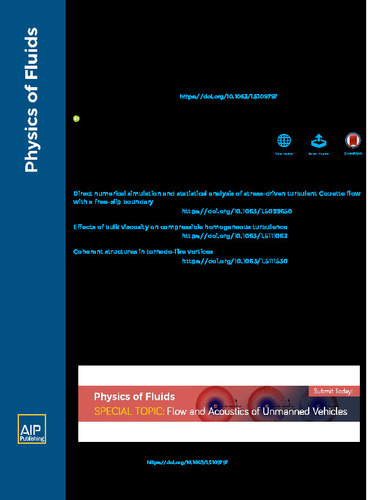| dc.contributor.author | Atoufi, Amir | |
| dc.contributor.author | Scott, K. Andrea | |
| dc.contributor.author | Waite, Michael L | |
| dc.date.accessioned | 2021-10-19 19:00:45 (GMT) | |
| dc.date.available | 2021-10-19 19:00:45 (GMT) | |
| dc.date.issued | 2019-08-20 | |
| dc.identifier.uri | https://doi.org/10.1063/1.5109797 | |
| dc.identifier.uri | http://hdl.handle.net/10012/17648 | |
| dc.description | The following article appeared in (Atoufi, A., Scott, K. A., & Waite, M. L. (2019). Wall turbulence response to surface cooling and formation of strongly stable stratified boundary layers. Physics of Fluids, 31(8), 085114. https://doi.org/10.1063/1.5109797) and may be found at (https://doi.org/10.1063/1.5109797). This article may be downloaded for personal use only. Any other use requires prior permission of the author and AIP Publishing. | en |
| dc.description.abstract | This paper investigates the processes by which stable boundary layers are formed through strong surface cooling imposed on neutrally stratified wall-bounded turbulence using high-resolution direct numerical simulation at a moderate Reynolds number. The adjustment of the flow to the imposed strong surface cooling is investigated. We further focus on a strongly stable case where turbulence partially collapses. We show that, due to a significant reduction in turbulence production, turbulence becomes patchy, with a band of turbulence coexisting with quiet regions. The nature of the quiet regions, which are often characterized as laminar, is investigated and shown to be consistent with viscously coupled stratified turbulence. The one-dimensional longitudinal streamwise velocity spectrum exhibits 𝑘−5𝑥 and 𝑘−3𝑥 behavior in the buffer and logarithmic layers, respectively, adjacent to an active region of three-dimensional turbulence with a 𝑘−5/3𝑥 spectrum. Scenarios for turbulence recovery from such a patchy state are also discussed. We show that the presence of outer layer turbulence above z+ ≈ 300 is a key requirement for recovery. For higher values of stratification, it is shown that inner layer turbulence is damped entirely and outer layer turbulence is damped subsequently. | en |
| dc.description.sponsorship | Funder 1, This research was enabled in part by support provided by the Shared Hierarchical Academic Research Computing Network (SHARCNET) || funder 2, Compute/Calcul Canada || Funder 3, the Natural Sciences and Engineering Research Council of Canada (K.A.S.: Grant No. RGPIN-418344-2012; and M.L.W.: Grant No. RGPIN-386456-2015) || Funder 4, and the Canadian Foundation for Innovation. | en |
| dc.language.iso | en | en |
| dc.publisher | AIP | en |
| dc.relation.ispartofseries | Physics of Fluids; | |
| dc.title | Wall turbulence response to surface cooling and formation of strongly stable stratified boundary layers | en |
| dc.type | Article | en |
| dcterms.bibliographicCitation | Atoufi, A., Scott, K. A., & Waite, M. L. (2019). Wall turbulence response to surface cooling and formation of strongly stable stratified boundary layers. Physics of Fluids, 31(8), 085114. https://doi.org/10.1063/1.5109797 | en |
| uws.contributor.affiliation1 | Faculty of Mathematics | en |
| uws.contributor.affiliation2 | Applied Mathematics | en |
| uws.typeOfResource | Text | en |
| uws.peerReviewStatus | Reviewed | en |
| uws.scholarLevel | Faculty | en |

